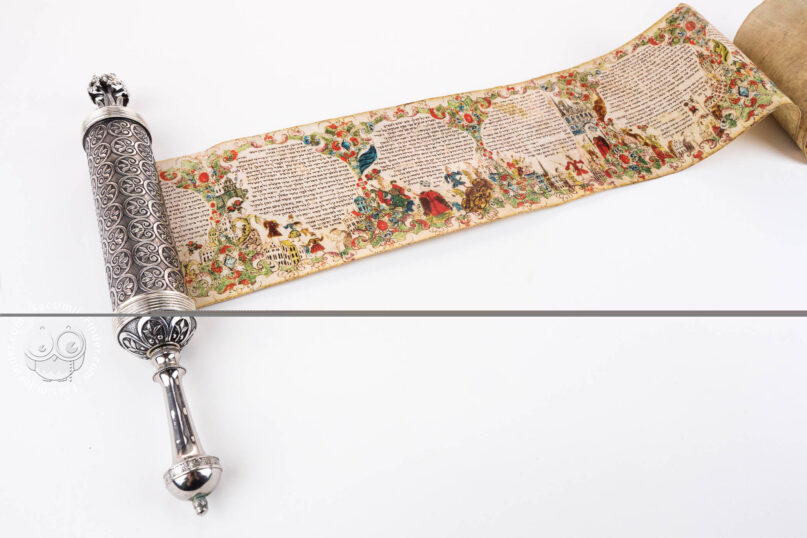
By Yoram Ettinger
(JNS) “Purimfest 1946!” yelled Julius Streicher, the Nazi propaganda chief, as he approached the hanging gallows in Nuremberg. On October 16, 1946, 10 convicted Nazi war criminals were hanged, just as the ten sons of Haman were hanged in ancient Persia.
Julius Streicher’s ranch served as a camp for young Jewish Holocaust survivors on their way to Israel. One of them was the late Eliezer Cotler, the grandfather of my son-in-law. While reading books in Streicher’s library, he noticed that the Nazi war criminal had a collection of books on Purim, with red ink underlining all references to the fate of the Amalekites and Haman.
Streicher assumed that the origin of the Aryan race was in Persia, with a connection to the descendants of the Amalekites, who were the worst enemies of the Jewish people. He believed that Purim documented the fate of the enemies of the Jewish people. Hence, Streicher’s yell, “Purim Fest 1946!”
Purim’s historical background:
A Jewish exile to Babylon and Persia was triggered by the 586 BCE destruction of the First Jewish Temple and the expulsion of Jews from Jerusalem, Judea and Samaria by the Babylonian emperor Nebuchadnezzar.
Persia then replaced Babylon as the leading regional power.
In 538 BCE, Xerxes the Great, Persia’s King Ahasuerus, the successor of Darius the Great, proclaimed his support for the reconstruction of the Temple and the resurrection of national Jewish life in the Land of Israel.
In 499-449 BCE, Ahasuerus established a coalition of countries—from India to Ethiopia—which launched the Greco-Persian Wars, aiming to expand the Persian Empire westward.
Persia was resoundingly defeated and Ahasuerus’s authority in Persia was gravely eroded.
Purim is a Jewish national liberation holiday, just like Passover and Hanukkah, which highlights optimism and the transition of the Jewish people from subjugation to liberty. It is celebrated seven days following the birth and death date of Moses—a role model of liberty, leadership and humility.
Purim is celebrated when the cold and stormy winter shifts into the upbeat, warm and pleasant spring.
Purim is celebrated on 14-15 Adar, which ushers in happiness. Adar is the root of the Hebrew adjective Adir (אדיר), which stands for the adjectives glorious, exalted and magnificent. It is also a derivative of the Akkadian word adura (heroism).
Remembrance is at the core the Purim holiday. The Scroll of Esther, which narrates the Purim saga, is also named the Book of Remembrance. The pre-Purim Sabbath is called the Sabbath of Remembrance (זכור), commemorating the deadly threat of the Amalekites (the ancestors of Haman), who aimed to annihilate the Jewish people following the deliverance from Egyptian bondage.
Queen Esther is Purim’s heroine. The Scroll of Esther is one of the five biblical scrolls, which are highlighted on Jewish holidays: Song of Songs (Passover), Scroll of Ruth (Pentecost), Lamentations (the 9th of Av, commemorating the destruction of the Jewish Temple), Ecclesiastes (Feast of Tabernacles) and the Scroll of Esther (Purim).
Esther (Mordechai’s niece or cousin) symbolized the centrality of women in Judaism, as did Sarah, Rebecca, Rachel and Leah (the Matriarchs), Miriam (Moses’s older sister), Batyah (who saved Moses’s life), Deborah (the prophetess, judge and military leader), Hannah (Samuel’s mother) and Yael (who killed Sisera, the Canaanite general).
Esther was one of the seven biblical Jewish prophetesses: Sarah, Miriam, Deborah, Hannah, Abigail, Huldah and Esther. Sarah lived 127 years and Esther was the queen of 127 countries.
The name Esther was a derivative of Ishtar, the Mesopotamian goddess of beauty and fertility, as well as Stara, the Persian morning star, which is a symbol of deliverance. The name evolved into Aphrodite and Venus, the Greek and Roman goddesses of love, beauty and fertility.
The Hebrew word for Venus is Noga, which is a biblical divine light and the second-brightest star after the moon. It is the name of my oldest, very special granddaughter.
The Hebrew name of Esther was Hadassah, whose root is hadas, meaning “myrtle tree.” The myrtle tree features prominently during the Feast of Tabernacles. It is known for its pleasant scent and humble features, including leaves in the shape of the human eye. Greek mythology identifies the myrtle tree with Aphrodite, the Greek goddess of love.
Mordechai, the hero of Purim and one of the deputies of Ezra the Scribe—who led a wave of Jewish ingathering from Babylon to the Land of Israel—was a role model of principle-driven optimism in defiance of colossal odds, in the face of a superpower, and in defiance of the assimilated Jewish establishment.
The first three Hebrew letters of Mordechai (מרדכי) spell the Hebrew word “rebellion” (מרד). Mordechai did not bow to Haman when the latter was the second most powerful person in the Persian Empire. Mordechai was a member of the tribe of Benjamin, the only son of Jacob who did not bow to Esau. Mordechai was a descendant of King Saul, who defied a clear commandment to eradicate the Amalekites, sparing the life of Agag, the Amalekite king, thus precipitating further calamities upon the Jewish people.
Mordechai learned from Saul’s crucial error and eliminated Haman, a descendant of Agag the Amalekite, thus sparing the Jewish people from a major disaster.
The aim of Mordechai, who became the chief advisor to the King of Persia, was to alert the assimilated Jewish community of Persia to the fact that forgetfulness and detachment from their Jewish roots would lead to oblivion, while the attachment to historic and religious roots is the foundation of growth, security and respect from fellow human beings.
The Hebrew root of the word Purim (פורים) is “fate” as well as “casting lots” (פור), commemorating Haman’s lottery, which determined a designated day for the annihilation of the Jewish people. It also means “to frustrate,” “to annul” (הפר), “to crumble” and “to shutter” (פורר), reflecting the demise of Haman.
Yoram Ettinger is a former ambassador and head of Second Thought: A U.S.-Israel Initiative.








 Southern New England Jewish Ledger
Southern New England Jewish Ledger









